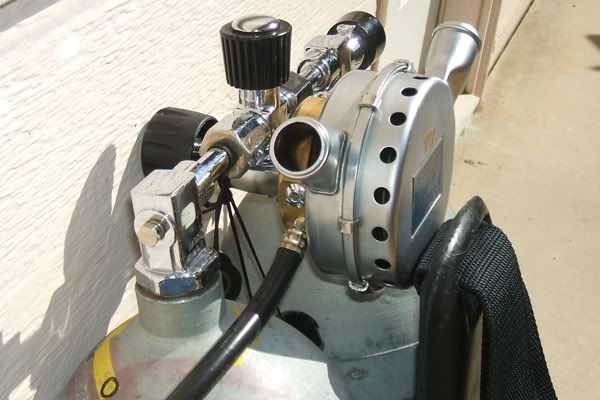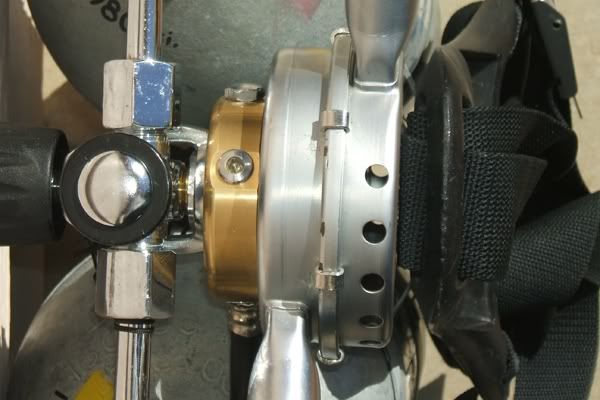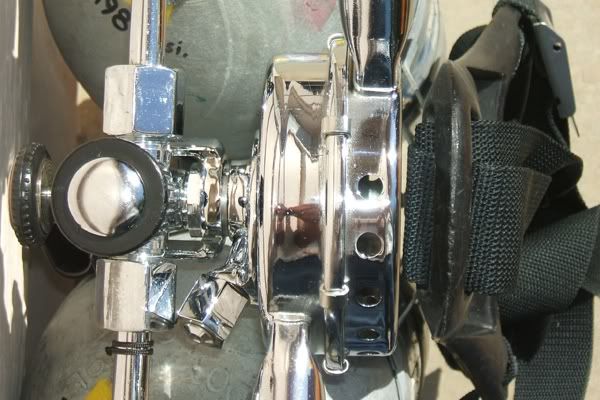I have had my first dive on my MB Mod 3 regulator today. It was is the Clackamas River, and it was a great dive. That is a mighty fine regulator. I will describe the dive a bit later, but it's early afternoon here, the sun's out, and I need to attend to chores.
__________________
Later in the evening:
Well, I have a bit of time now, and so will describe the dive with the Mossback Mk 3 Aquamaster. I had it set up on my double 45s, with a Sherwood valve (2 posts). I have a Calypso second stage mounted on the Mk 3 for my safe second, and on the other post I put a very old, vintage Calypso (all metal, with the exhalation valve on the diaphragm). So basically I had two safe seconds. I had an LP inflator hose for my ParaSea BC too. I dove a full wetsuit, complete with hood, boots and gloves (the reason apparent in the next paragraph). The Mk 3 was mounted centrally, below the valve height for nice breathing.
I dove the Clackamas River today, as we have had over a week of very nice, sunny weather (much to the chagrin of the Vancouver Winter Olympics). This has made the river here very clear (15 feet plus visibility), but cold (probably around 38 degrees F). The river was not terribly high, but high enough to submerge the island that is normally at the High Rocks area just above the top hole. The current was pretty fast, coming in and making a whirlpool just below where I entered. I had thought about entering below this area, but then decided I'd just swim through it and into a pool on the other side.
At the river's edge, I found two rocks situated so that it was relatively easy to sit down with my doubles on the rock, put on my fins and then my mask, helmet (with snorkel--it's yellow for visibility with florescent yellow tape on it). I set my Seiko watch, and put the mouthpiece in my mouth. After taking a few breaths, I submerged and swam out into the current. The current was running between 4 and 8 knots (quite fast in places). I swam on the surface through the whilepool, then submerged to the bottom with a surface dive on the other side. I got down and decided it was great visibility. The bottom was rock, with some very large rocks where I could shelter from the current. This I did, and relaxed to decide how the Mk 3 was doing. The breathing was effortless, but not blowing through to the exhaust. It gave me exactly what I needed. I was fairly deep, at about 23 feet (deep for the river), and so blew a bit of air into my BC. I drifted with the current for a minute, then swam against it (about 3 knots at the bottom. The Mk 3 gave me all the air I needed on exertion with almost no effort.
I then switched to my Calypso second stage, which had come loose from my BC (I have a pocket on the Para-Sea BC for an octopus)--the hose was just a bit too short. The Calypso metal second stage (third generation) breathed just like it was hooked up to a Titan first stage--which it actually was, as that is what the MB Mk 3 uses for a first stage. I switched back to the double hose mouthpiece, and cleared it with no problem, rolling to get all the water out of the exhaust. I continued drifting downstream.
After about five minutes (going fairly fast) I decided to make a maximum effort against the current to see how the regulator performed. I was able to make a bit of headway in the high current, but only by holding onto rocks embedded in the bottom and going hand-over-hand upstream. The Mk 3 performed very well, with no "starvation" for air at maximum exertion. I was at about 15 feet for these efforts.
I let go, and continued my drift. Looking up, I saw the bridge above me, which is a pedestrian bridge. The last time I saw it from underwater last fall, it had streams of rain water running off and splashing on the surface--an interesting sight from underwater. Today, in bright sunshine, it was a shadow on the bottom. I knew that my exit was coming up soon. I surfaced to see where I was, and noted I was almost to the exit. So I began swimming toward the exit on the side of the river from the bottom.
Then I saw just upstream from me a "D" ring that someone had dropped, and I wanted to grab it. I got to the bottom, and tried swimming upstream to get to it. I was going as fast as I could, and not making much headway. So I grabbed at some rocks, but most of them were not solidly tied to the bottom. Then I found an "L" shaped piece of iron, grabbed it, and thrust it forward to the "D" ring. The iron went through the "D" ring, and I turned it over to bring it to me. Taking it off the iron, I discarded the iron and put the "D" ring into my BC pocket. I had it!
In the current, the MB Mk 3 performed extremely well. My only complaint is that I have a new silicone mouthpiece on it, and it is pretty soft. In the current, that mouthpiece actually bent a bit and because of the soft bite was somewhat difficult to keep in my mouth. But that wasn't the Mk 3, but my new mouthpiece that was a slight problem (distorting a bit in the high current).
I swam to the side, surfaced and looked up. There was a walker watching me from the pedestrian path above me, and a guy with a dog below. As I found a foothold and stood up, the guy with the dog left, but the fellow above me stayed. I waved, and he waved back. It took me a couple of minutes to get my fins off, find my footing and exit the water. As I came up to the path, there was a guy there (I think the same one), and he and I talked a bit. I told him that I was testing a new regulator, and he talked a bit about Jacques Cousteau, saying that "if it wasn't for an accident, Cousteau would have been flying rather than diving. I wonder what he could have done of aviation if he had gone that route." I told him that a car accident changed the course of history for diving (he was obviously a diver), and we talked a bit about equipment. Then he continued his walk, and with twin 45s on my back and 22 pounds of lead on my waist, I couldn't keep up with him.
I walked back to my car with the satisfaction of having successfully put the MB MK 3 through a pretty rough dive, even if it was short at about 17 minutes total. I started with about 1600 psig, and ended with 750 psig, for a use of 850 psig on the dive. I'll do some calculations and add them later tonight here:
850 psig / 17 minutes = 50 psig/minute
1800 psig @ 90 cubic feet is 1800 psig / 90 cf = 20 psig/cf
50 psig/minute / 20 psig/cf = 2.5 cf/minute
That's about 71 liters per minute. Since I have a vital capacity of 5 liters, but probably only use 3.5 liters per breath, that's about 15-20 breaths per minute. So I was exercising fairly heavily to get that usage rate.
It as a great dive, first of the year for me in open water. I think I have a new "best performing double hose regulator," the Mossback Mk 3. It is right there, or better than, my highly modified Trieste II, and has all the abilities of the Trieste II too (more LP ports and a HP port).
One measure of a double hose regulator is it's negative pressure breathing--how that affects the diver. Usually, inhalation breathing under negative pressure is a diuretic (make one produce more urine). This is a characteristic of most double hose regulators because of both the position in the water column in relation to the lungs, and the inhalation resistance of the regulator. I almost always have to get to the McDonald's Restaurant near the dive site, buy a small hamburger (not the big greasy ones), and use their restroom post-dive. But today, I brought a banana and a Coke to drink on the drive back to Beaverton, as I did not have time to stop--there was a critical budget meeting at my church. I went there in my swim trunks to vote, which is neither here nor there. But I didn't need to stop for a rest stop. While this is a rather subjective means of ascertaining the effectiveness of a regulator, it shows that for me the Mk 3 did not have a diuretic effect, unlike most of my double hose regulators.
SeaRat













